Thursday, August 24, 2006
Wednesday August 9th—Brussels
We arrived back in Brussels about dark. We got a taxi to take us to our hostel. We had already been there that morn and left our luggage.
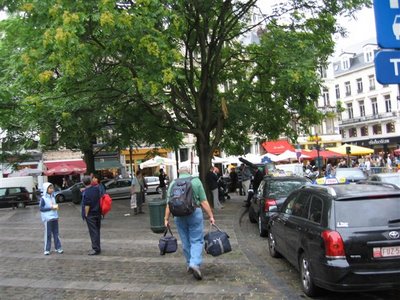
We didn’t see much of the housing, but we did see that we were in the old historic section of Brussels. We did not explore any that night, but we got up and went out early the next morning and lined us up a tour of the city. We discovered that we were within walking distance to most of the Old City Attractions. In fact, after our tour ended we walked around and re-visited several places and took some pictures. It was not a good day for pictures. It was very cloudy and rained most of the day. I held the umbrella for Mary to keep her dry while she took a lot of the pictures. We did not do a lot of shopping but we did walk down the major shopping street in the city.
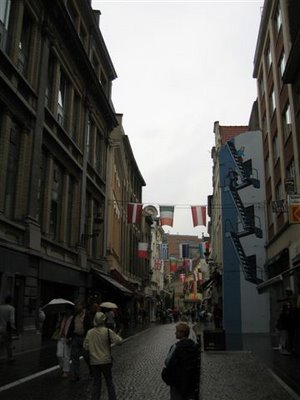
We visited the chocolate shops and the lace shops. We went to see the original of the Petite Juliean (the bronze statute of the little boy peeing). I had seen that picture a lot, but I never knew what it was called or where it was. Mary wanted a picture of it and when we got there it was dressed up in an old style military uniform for some holiday they were celebrating.

Mary was real disappointed. For lunch, we stood in the rain and ate a Belgium waffle with chocolate dripping off it. We finally made our way back to our hotel. We both thought that our hostel accommodations were outstanding.
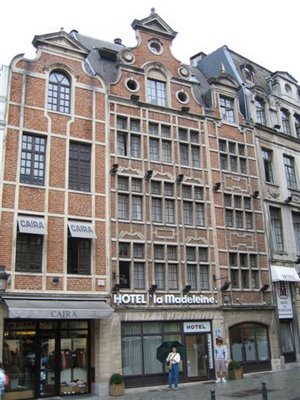
The room, the staff, and the breakfast we had was outstanding. Most hostels include some kind of breakfast in the cost of an overnight.
We were directed to a tourism office at the Grand’ Place, or Grote Markt in Flemish. There are two official languages in Brussels. In the North part of Belgium the official language is Flemish, while due to the French influence in the country's development, the language in the south of Belgium is French. Most of the buildings and streets have both of the languages on their signs. Be that as it may, the Grand’ Place is the most beautiful and impressive sight which have seen in our European experience. The guide books describe it as Flemish Renaissance and Gothic. I think that it is just beautiful. The key stone of the square is the Town Hall.
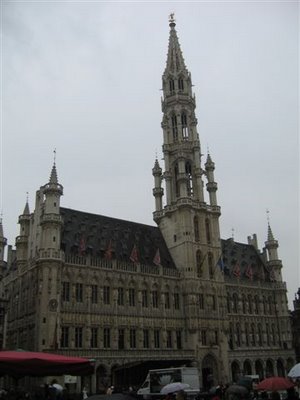
It is the tallest and the most impressive. Across the square from it is the King’s House,
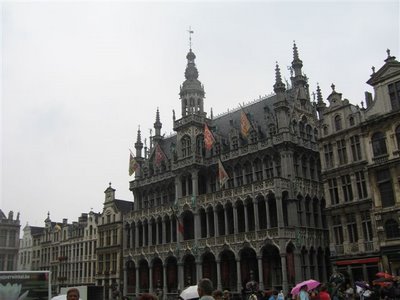
built for Charles II when Spain was ruling Belgium. The other buildings on the square were built by Charles II for the different guilds.
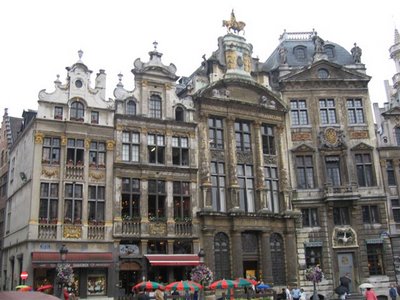
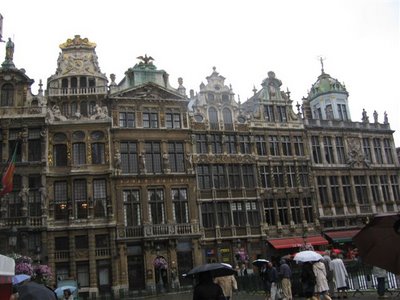
The butchers, bakers, builders, boatmen and even lawyers had their own building and places to do business. This was pretty forward thinking for the 1800’s. There is also a shopping mall which is the oldest in Brussels.
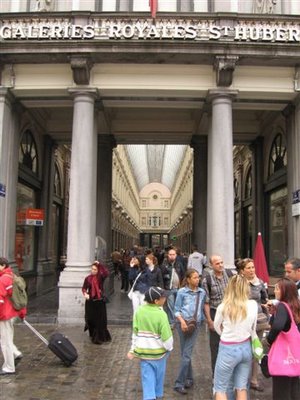
It is still active and serving the shoppers of the city and it was opened in 1847. Most of these old buildings do not date back past about 1690. Louie XIV got a little upset with Belgium and his armies bombarded the city and many of the old wooden structures were destroyed. The city immediately rebuilt the grand’ Place and surrounding area with stone as you see it today. Among the most outstanding innovators of the molding of modern Brussels was Charles Karl Buls. He was the mayor of Brussels from 1881 until 1899. There is a statue of him and his dog in a little park just across the street from our hostel, which is just around the corner from the Grand’ Place.
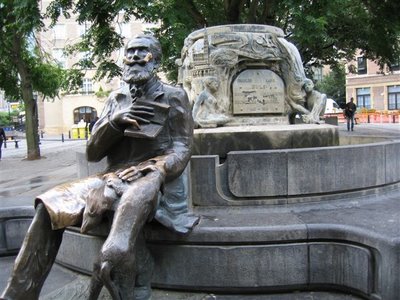
Just back up the street from our hostel was the Cathedral of St Michael. This is the oldest and most important church in the City. It dates to the 16th Century. It is believed that it resembles the Notre Dame Cathedral in Paris.
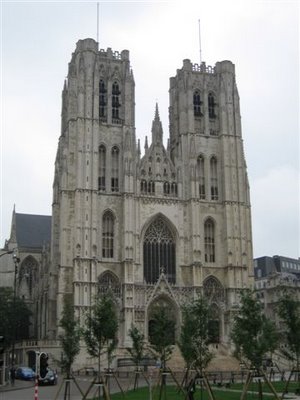
If it does it is on a much smaller scale. Another church which is important to the population of the city is Our Lady of Laeken Church. The significance of this church is that it is the burial place for the Belgium Royalty. There is a statue up the hill from the Cathedral which is in Honor of the first King of Belgium, King Leopold I.

He took the throne in 1831. At the base of the statue is an eternal flame on the tomb of the Unknown Soldier honoring the dead from WWI and WWII.
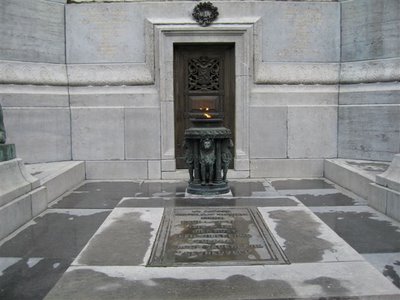
Brussels did not suffer the damage of many other cities in Europe during WWII because they surrendered after only 18 days and were an occupied country for the remainder of the war.
There is considerable Spanish influence in the growth of Brussels and all of Belgium. There is a section of the city which fronts the Cathedral which is strongly Spanish in it organization and architecture. In the center of this section is a statue of Don Quixote and his sidekick mounted on his mule.
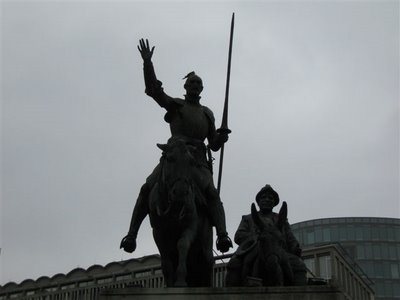
This statue was given by Spain in memory of their rule in Belgium. Today the seat of government is in the National Palace built in the 18th Century during the Austrian occupation.
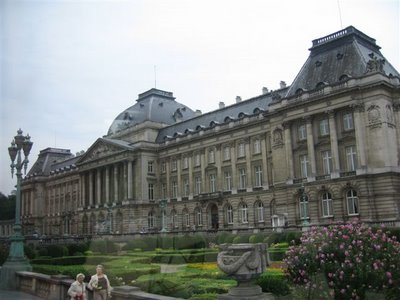
After 1831 when the Leopold took over the rule of Belgium some of the efforts of the government were turned inward to improve the infrastructure of the country. Leopold II established Jubilee Park to celebrate 75 years of Home rule. Now it is home for three of the National Museums and after WWI the Triumphal Arch was added to the park to honor the countries war effort.
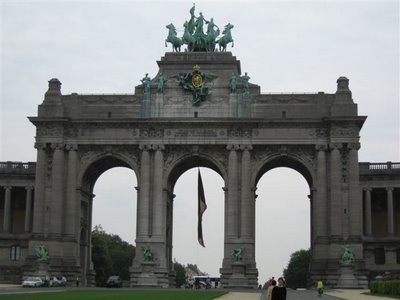
It looks like a cross between the Arch de Triumph and Brandenburg Gate.
Brussels hosted the Worlds Fair in 1958. There are a lot of left overs from that exhibition. Most notable is the Model of the Iron Atom which is displayed in Hazel Park.
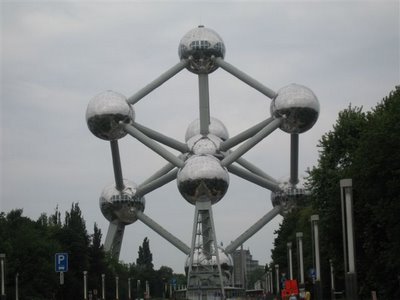
It has come to be an icon for the attitude of Brussels. Most of the new building and growth came with and after this world exposure. Today Belgium has a population of around ten million. Brussels has about one million of those. Twenty seven percent of Brussels population is foreign nationals. This is due to the fact that Brussels is the capitol of the European Union and NATO. The EU has 25 member countries and twenty different official languages and they still do business.
The European Union has a magnificent building which houses their government.
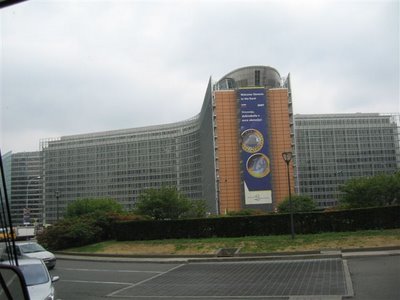
There is a footbridge which connects the two houses of its Parliament. The EU employees over 30,000 people and contributes greatly to the economy of Brussels and Belgium. Exports from Belgium are the largest of any country in the EU and it is the most profitable of any.
Over all I thought that Brussels to be the most beautiful of any city which we have visited. Because they did not suffer the bombings of WWII they have a lot of their old building still standing. A part of the beauty may also be the attitude of the people and the atmosphere of the city.
We finally tore ourselves away from a great city and boarded a train to go to Paris. We are to be in Paris from Wednesday night until Saturday morning.
We arrived back in Brussels about dark. We got a taxi to take us to our hostel. We had already been there that morn and left our luggage.

We didn’t see much of the housing, but we did see that we were in the old historic section of Brussels. We did not explore any that night, but we got up and went out early the next morning and lined us up a tour of the city. We discovered that we were within walking distance to most of the Old City Attractions. In fact, after our tour ended we walked around and re-visited several places and took some pictures. It was not a good day for pictures. It was very cloudy and rained most of the day. I held the umbrella for Mary to keep her dry while she took a lot of the pictures. We did not do a lot of shopping but we did walk down the major shopping street in the city.

We visited the chocolate shops and the lace shops. We went to see the original of the Petite Juliean (the bronze statute of the little boy peeing). I had seen that picture a lot, but I never knew what it was called or where it was. Mary wanted a picture of it and when we got there it was dressed up in an old style military uniform for some holiday they were celebrating.

Mary was real disappointed. For lunch, we stood in the rain and ate a Belgium waffle with chocolate dripping off it. We finally made our way back to our hotel. We both thought that our hostel accommodations were outstanding.

The room, the staff, and the breakfast we had was outstanding. Most hostels include some kind of breakfast in the cost of an overnight.
We were directed to a tourism office at the Grand’ Place, or Grote Markt in Flemish. There are two official languages in Brussels. In the North part of Belgium the official language is Flemish, while due to the French influence in the country's development, the language in the south of Belgium is French. Most of the buildings and streets have both of the languages on their signs. Be that as it may, the Grand’ Place is the most beautiful and impressive sight which have seen in our European experience. The guide books describe it as Flemish Renaissance and Gothic. I think that it is just beautiful. The key stone of the square is the Town Hall.

It is the tallest and the most impressive. Across the square from it is the King’s House,

built for Charles II when Spain was ruling Belgium. The other buildings on the square were built by Charles II for the different guilds.


The butchers, bakers, builders, boatmen and even lawyers had their own building and places to do business. This was pretty forward thinking for the 1800’s. There is also a shopping mall which is the oldest in Brussels.

It is still active and serving the shoppers of the city and it was opened in 1847. Most of these old buildings do not date back past about 1690. Louie XIV got a little upset with Belgium and his armies bombarded the city and many of the old wooden structures were destroyed. The city immediately rebuilt the grand’ Place and surrounding area with stone as you see it today. Among the most outstanding innovators of the molding of modern Brussels was Charles Karl Buls. He was the mayor of Brussels from 1881 until 1899. There is a statue of him and his dog in a little park just across the street from our hostel, which is just around the corner from the Grand’ Place.

Just back up the street from our hostel was the Cathedral of St Michael. This is the oldest and most important church in the City. It dates to the 16th Century. It is believed that it resembles the Notre Dame Cathedral in Paris.

If it does it is on a much smaller scale. Another church which is important to the population of the city is Our Lady of Laeken Church. The significance of this church is that it is the burial place for the Belgium Royalty. There is a statue up the hill from the Cathedral which is in Honor of the first King of Belgium, King Leopold I.

He took the throne in 1831. At the base of the statue is an eternal flame on the tomb of the Unknown Soldier honoring the dead from WWI and WWII.

Brussels did not suffer the damage of many other cities in Europe during WWII because they surrendered after only 18 days and were an occupied country for the remainder of the war.
There is considerable Spanish influence in the growth of Brussels and all of Belgium. There is a section of the city which fronts the Cathedral which is strongly Spanish in it organization and architecture. In the center of this section is a statue of Don Quixote and his sidekick mounted on his mule.

This statue was given by Spain in memory of their rule in Belgium. Today the seat of government is in the National Palace built in the 18th Century during the Austrian occupation.

After 1831 when the Leopold took over the rule of Belgium some of the efforts of the government were turned inward to improve the infrastructure of the country. Leopold II established Jubilee Park to celebrate 75 years of Home rule. Now it is home for three of the National Museums and after WWI the Triumphal Arch was added to the park to honor the countries war effort.

It looks like a cross between the Arch de Triumph and Brandenburg Gate.
Brussels hosted the Worlds Fair in 1958. There are a lot of left overs from that exhibition. Most notable is the Model of the Iron Atom which is displayed in Hazel Park.

It has come to be an icon for the attitude of Brussels. Most of the new building and growth came with and after this world exposure. Today Belgium has a population of around ten million. Brussels has about one million of those. Twenty seven percent of Brussels population is foreign nationals. This is due to the fact that Brussels is the capitol of the European Union and NATO. The EU has 25 member countries and twenty different official languages and they still do business.
The European Union has a magnificent building which houses their government.

There is a footbridge which connects the two houses of its Parliament. The EU employees over 30,000 people and contributes greatly to the economy of Brussels and Belgium. Exports from Belgium are the largest of any country in the EU and it is the most profitable of any.
Over all I thought that Brussels to be the most beautiful of any city which we have visited. Because they did not suffer the bombings of WWII they have a lot of their old building still standing. A part of the beauty may also be the attitude of the people and the atmosphere of the city.
We finally tore ourselves away from a great city and boarded a train to go to Paris. We are to be in Paris from Wednesday night until Saturday morning.